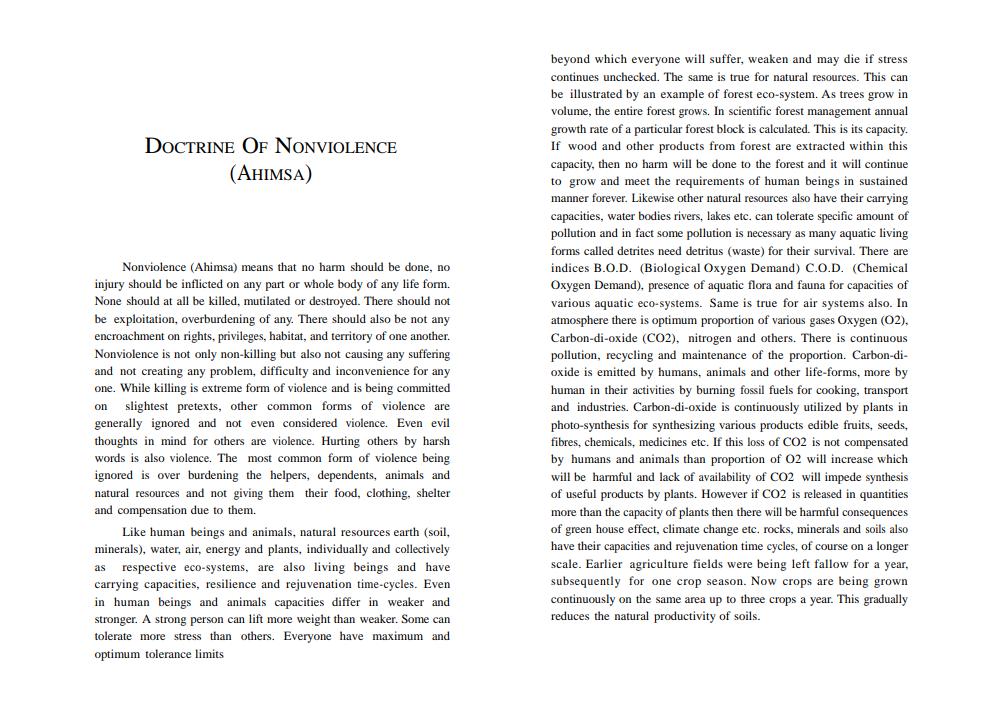________________
DOCTRINE OF NONVIOLENCE
(AHIMSA)
Nonviolence (Ahimsa) means that no harm should be done, no injury should be inflicted on any part or whole body of any life form. None should at all be killed, mutilated or destroyed. There should not be exploitation, overburdening of any. There should also be not any encroachment on rights, privileges, habitat, and territory of one another. Nonviolence is not only non-killing but also not causing any suffering and not creating any problem, difficulty and inconvenience for any one. While killing is extreme form of violence and is being committed on slightest pretexts, other common forms of violence are generally ignored and not even considered violence. Even evil thoughts in mind for others are violence. Hurting others by harsh words is also violence. The most common form of violence being ignored is over burdening the helpers, dependents, animals and natural resources and not giving them their food, clothing, shelter and compensation due to them.
Like human beings and animals, natural resources earth (soil, minerals), water, air, energy and plants, individually and collectively as respective eco-systems, are also living beings and have carrying capacities, resilience and rejuvenation time-cycles. Even in human beings and animals capacities differ in weaker and stronger. A strong person can lift more weight than weaker. Some can tolerate more stress than others. Everyone have maximum and optimum tolerance limits
beyond which everyone will suffer, weaken and may die if stress continues unchecked. The same is true for natural resources. This can be illustrated by an example of forest eco-system. As trees grow in volume, the entire forest grows. In scientific forest management annual growth rate of a particular forest block is calculated. This is its capacity. If wood and other products from forest are extracted within this capacity, then no harm will be done to the forest and it will continue to grow and meet the requirements of human beings in sustained manner forever. Likewise other natural resources also have their carrying capacities, water bodies rivers, lakes etc. can tolerate specific amount of pollution and in fact some pollution is necessary as many aquatic living forms called detrites need detritus (waste) for their survival. There are indices B.O.D. (Biological Oxygen Demand) C.O.D. (Chemical Oxygen Demand), presence of aquatic flora and fauna for capacities of various aquatic eco-systems. Same is true for air systems also. In atmosphere there is optimum proportion of various gases Oxygen (O2), Carbon-di-oxide (CO2), nitrogen and others. There is continuous pollution, recycling and maintenance of the proportion. Carbon-dioxide is emitted by humans, animals and other life-forms, more by human in their activities by burning fossil fuels for cooking, transport and industries. Carbon-di-oxide is continuously utilized by plants in photo-synthesis for synthesizing various products edible fruits, seeds, fibres, chemicals, medicines etc. If this loss of CO2 is not compensated by humans and animals than proportion of O2 will increase which will be harmful and lack of availability of CO2 will impede synthesis of useful products by plants. However if CO2 is released in quantities more than the capacity of plants then there will be harmful consequences of green house effect, climate change etc, rocks, minerals and soils also have their capacities and rejuvenation time cycles, of course on a longer scale. Earlier agriculture fields were being left fallow for a year, subsequently for one crop season. Now crops are being grown continuously on the same area up to three crops a year. This gradually reduces the natural productivity of soils.




